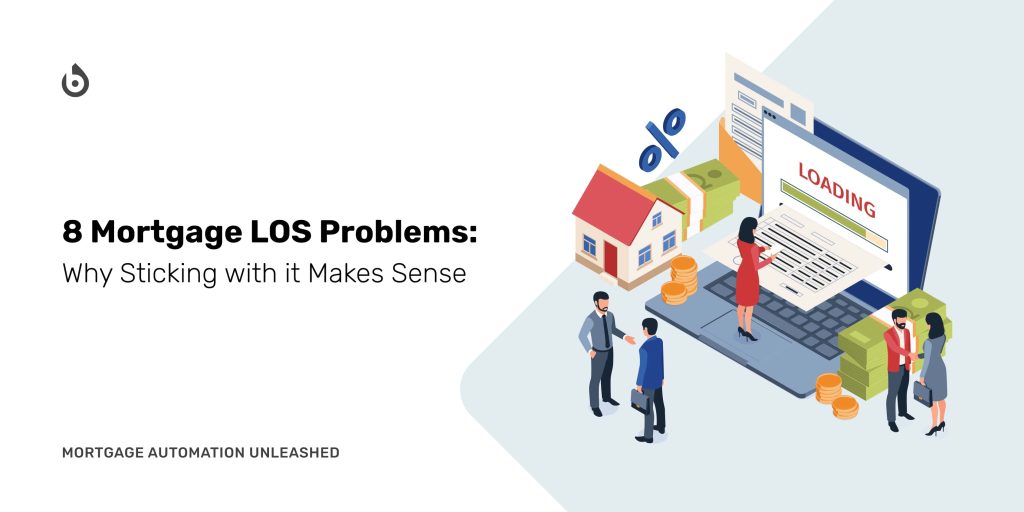August 8, 2023 | 3 min read
Why you should keep your LOS despite what’s wrong with it

Mario DiBenedetto
Managing Director

Based on our experience developing mortgage-related software for top 50 lenders for over 20 years, we know that all lenders suffer the same 8 challenges around their loan origination system, regardless of which system they are using. Our assertions are two-fold:
- First, it is highly unlikely that you will eliminate ANY of these 8 issues by changing your LOS. To be clear, we are not saying you can’t eliminate ALL 8, we are stating you will not eliminate ANY.
- Second, given the first assertion, your resources and energy are better served at “fixing” what you have.
This article is being separated as 3 different parts, Part I and Part II will review each of the 8 challenges in-depth and Part III will emphasize on why you should retain your LOS despite the problems being faced by the lenders. See if you can relate to how each of the issues manifests itself in your company and whether you have any confidence they will be eliminated.
Why You Shouldn’t Switch Away from your LOS despite
all of its problems
If you’ve read this far, the situation around “solving” your loan origination challenges might seem more daunting than ever. Up until this point, this article has spent ~4,000 words to tell you how the eight key problem areas are all worse when you look at them more closely.
To counter all of that doom-and-gloom, let’s lay-out some LOS truisms that start to alter the way we look at your current situation:
- No LOS is perfect. Know that if you are going to switch to a different LOS that you will not be without issues. And, as stated above, unless you are one of the few lenders that takes the time to perform a deep introspection of your own processes and runs a long, rigorous RFP process, you likely will not even know what problems await you until you get to the end of the implementation process.
- The statistics for failed or abandoned LOS switchover projects are frighteningly not in your favor. Twenty years ago, we used to
approach Top 50 lenders and say that if you could not convert an entire channel onto a new LOS in less than 9 months, your business would likely change too much and too fast to successfully implement the original plan. That is, if you take too long, expect to take even longer. Today, that window of opportunity is probably less than 6 months.
- While the technology used by your LOS has limitations, the technology available to you to improve your situation is almost limitless. The general technology market is more innovative than the mortgage technology industry. The result is that there are technologies that you can leverage with little-to-no dependency on your LOS. And these same technologies are both more cost effective and more likely to have a wide set of people who are versed in implementing the technologies. So both the upfront and ongoing costs to implement can be more compelling than adopting mortgage-specific technology.
Given this LOS landscape, hopefully you see at least a small window of opportunity whereby staying on your existing LOS makes more sense, even with its host of issues. Let’s take these items in reverse order and talk about how they each can play to your advantage.
Limitless Technology
There are so many “playbooks” for how you can implement automation that sometimes it’s dizzying, even to those of us that live in technology every day. The technology world knows that every industry has “legacy” systems that are hard to use, or slow, or lack automation.
Technologies like Robotic Process Automation (RPA), which started out as a tool that could mimic your keystrokes and mouse clicks, were specifically designed for outdated software that was otherwise impossible to work around. Tools like Zapier provide 1,000+ different “connectors” that let you move data and documents from one system to another. And they can easily use low-tech methods that even the oldest LOS likely supports.

If you have access to your LOS data, there are ways to latch onto data changes and trigger automations, notifications, and tasks without ever touching your LOS. And if you use tools like Microsoft Teams or Slack, there are ways to push data, notifications, and tasks into those tools to make them more easily consumed.
The point is, the technology world offers a lot of creative ways to solve some of your pain points. While there is no single technology that offers a silver bullet to fix all of your problems, there are lenders who are having success using best of breed technologies to eliminate problems one-by-one and improve their productivity and scalability.
High Switchover Costs
As stated above, your cost to switch to a new LOS consists of:
- The direct LOS charges (licenses + per loan)
- The statistics for failed or abandoned LOS switchover projects are frighteningly not in your favor.
- The organization change expenses you will incur planning and rolling-out the new LOS
The one additional cost that was not yet mentioned is the period time where you will be expected to make no changes to your existing LOS (because, why would you put the effort in if you are abandoning it) and, at the same, time, freeze the requirements for the new LOS so the project is not trying to hit a moving target. You have to compound this by the fact that you cannot define and assimilate any pent-up demand for change overnight
when the new LOS is turned on because there is an inevitable “burn in” period where all of the new issues with the LOS need to be resolved before you can effectively start making changes.

So, let’s be generous and say that you only have to freeze your business for 9 months before you can start to assimilate change. Look backwards to 9 months prior to today and try to imagine how you would have survived if you were committed to no changes to your LOS or the dependent business processes. Does that seem even remotely realistic?
LOS vendors are in the business of convincing you not only how much better your life will be once you implement their product, but also how they make the switchover easy. It’s rarely easy. One exception is an LOS vendor we know that has a track record of consistently implementing in 3 months or less. But they can only accomplish that because they support a limited set of 3rd-party vendors. This is fine if you are a regional lender or only originate a limited set of products. Anything more complicated and these limitations are likely deal killers for you.
LOS Project Failure Rates
As the prior section notes, it is costly to switch LOSs and you will have to freeze your business while you do it. Add to that there’s a 50% chance that at the end you will fail? That’s just a dogpile on the rabbit.
Do yourself a favor and, before you start a LOS switchover project, perform this thought experiment:
- Just based on your current experience, calculate what you think the annual cost will be for a new LOS for your organization. If you don’t know and want to use round numbers, estimate $100-$175 per closed loan. That estimate, by the way, does not include the 3rd-party vendor service fees you will have to pay on every loan. We’ll just assume those are a wash in this equation.
- Multiple #1 by 4 to get the combination of the annual cost plus the cost to implement.
- Double #2 to get the cumulative total including the costs you will incur for organizational change.
- The $s in #3 are what you are putting at risk
- Consider what improvements you could make to your existing LOS with a fraction of those costs.
- Consider that, depending on the playbook you use, you could start realizing the benefits of improving your existing system as fast as 2-4 weeks.
- Consider that each project you do to improve your existing LOS might have the same 50% failure rate individually, but you have a more balanced risk posture because your benefits do not all hinge on the success or failure of one massive project.
No LOS is Perfect
What’s the longest RFP you’ve ever seen for a mortgage loan origination system? We’ve seen them exceed 1,000 questions. And, even with that level of detail, it is guaranteed that:
- You will miss important business scenarios that should be assessed against the prospective LOSs.
How could you not miss scenarios given the millions of permutations across loan type, loan purpose, channel, loan product, origination source, geography, borrower demographics, etc? Plus trying to discover the “special” ways your team operates that are likely undocumented. And, most importantly, trying to assess all of this against a new operating model on which you’ve never executed.
- The responses you get from LOS vendors will not be ironclad YES/NO decisions.
Rather, they will be full of vagaries that require iterative follow-ups with the LOS vendors to clarify their commitment. Larger lenders can afford to enlist a 3rd-party to run their RFP process and ensure “tighter” responses. Even then, it’s a painstaking process to evaluate every word of every RFP response to make sure key requirements are not left unclear.
- Even if the LOS is awesome and gives you great tools to implement it, there is a high likelihood you will mess it up during your implementation.


